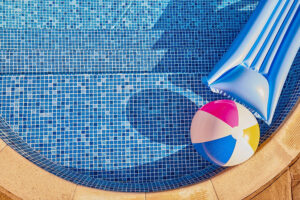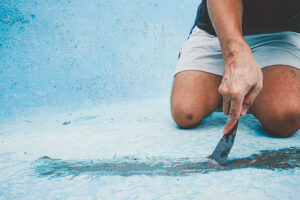The blistering temps in our state mean you’re probably used to spending a good amount of time splashing around in your backyard oasis. But with great fun comes great responsibility. One crucial aspect of pool maintenance is shock treatment. This simple but essential step is key to keeping your pool sparkling clean and safe. But do you know how to properly shock your pool and when it might need a little extra attention? We’re going to guide you through the process and let you know what signs to look out for, indicating your pool may need more than the typical shock treatment.

Keep Your Pool Running Properly.
Get a FREE Equipment Inspection from Sea Breeze Pools Today!
Understanding Shock Treatment
Before we delve into the process, it’s important to understand what shock treatment is. Pool shocking is the process of super-chlorinating the pool water to kill bacteria, algae, chloramines, and other contaminants. It’s a crucial part of pool maintenance, especially when you use your pool frequently or after significant use, like a pool party.
Steps to Shock Your Pool
Shocking your pool is relatively easy and straightforward. Here’s a step-by-step guide:
1. Choose Your Pool Shock
Start by choosing your shock product. The most common types are calcium hypochlorite, dichlor, and non-chlorine shocks. Each type has different strengths and weaknesses, so do some research to find out which one suits your needs best.
2. Safety First
Before you start, don your safety gear. Shock treatment chemicals can be hazardous. At a minimum, you should wear gloves and safety glasses to protect your skin and eyes.
3. Calculate Your Pool Volume
Next, calculate your pool volume. This will determine how much shock you need. Typically, one pound of shock treats 10,000 gallons of water. You’ll want to shock your pool after sundown to prevent UV light from degrading the chlorine before it has a chance to do its job.
4. Pre-Dissolve the Shock
Pre-dissolve your chosen shock in a bucket of water from your pool. Always add shock to water and not water to shock to prevent a violent reaction.
5. Broadcast the Shock
Slowly pour the dissolved shock into your pool, walking around the pool’s perimeter. This helps to distribute it evenly.
6. Run Your Pump
After adding the shock, run your pool pump for at least 8 hours to ensure the shock is circulated thoroughly.
7. Test Your Water
Finally, test your pool water after 24 hours. The chlorine level should read between 1.0 and 3.0 parts per million.
Signs That Your Pool Needs More Shock Treatment
So how do you know if your shock treatment has been effective? Here are some signs to look out for:
1. Persistent Cloudiness
If your pool water remains cloudy 24 hours after shock treatment, this might indicate that the shock wasn’t entirely effective. The cloudiness could be due to an overabundance of bacteria, which the shock should kill.
2. Green Water
Green pool water usually means one thing – algae! If your pool is still green after the shock treatment, you might need to shock it again. Green water may also require an algaecide treatment.
3. Chlorine Smell
Despite popular belief, a strong chlorine smell isn’t an indication of too much chlorine, but rather of chloramines. Chloramines form when chlorine reacts with contaminants, and they’re ineffective at sanitizing. If your pool has a strong chlorine smell, it may need another round of shock treatment to get rid of the chloramines.
4. Burning Eyes and Itchy Skin
Another indication that your pool needs more shock treatment is if swimmers are experiencing burning eyes and itchy skin. This can be a sign of a high level of chloramines or a poor pH balance. Shock treatment can help restore a balanced chemical state in your pool, reducing these uncomfortable symptoms.
Sea Breeze Pools: Keeping Your Pool Water Balanced and Safe
Regular pool maintenance is a must for any pool owner in Central Florida, especially during the summer months when our pools see heavy use. Shock treatment plays a significant role in ensuring your pool remains safe, clean, and ready for use. While it’s relatively straightforward, knowing when to shock, how to shock, and the signs to look out for indicating a need for more treatment is essential.
Remember, if you’re continually having to shock your pool or your water balance is consistently off, it might be time to consult our pool professionals at Sea Breeze Pools. We can troubleshoot your issues and provide the appropriate treatment or guidance to keep your pool water clean and ready for fun in the sun!
Got a Pool Problem? We Can Help.
Contact Sea Breeze Pools Today for a FREE Quote
Sea Breeze Pools services the following locations in Greater Central Florida:
Apopka, Lake Mary, Metro West, Mt. Dora, Oakland, Orlando, Sorrento, Longwood, Ocoee, Windermere, and Winter Garden.






